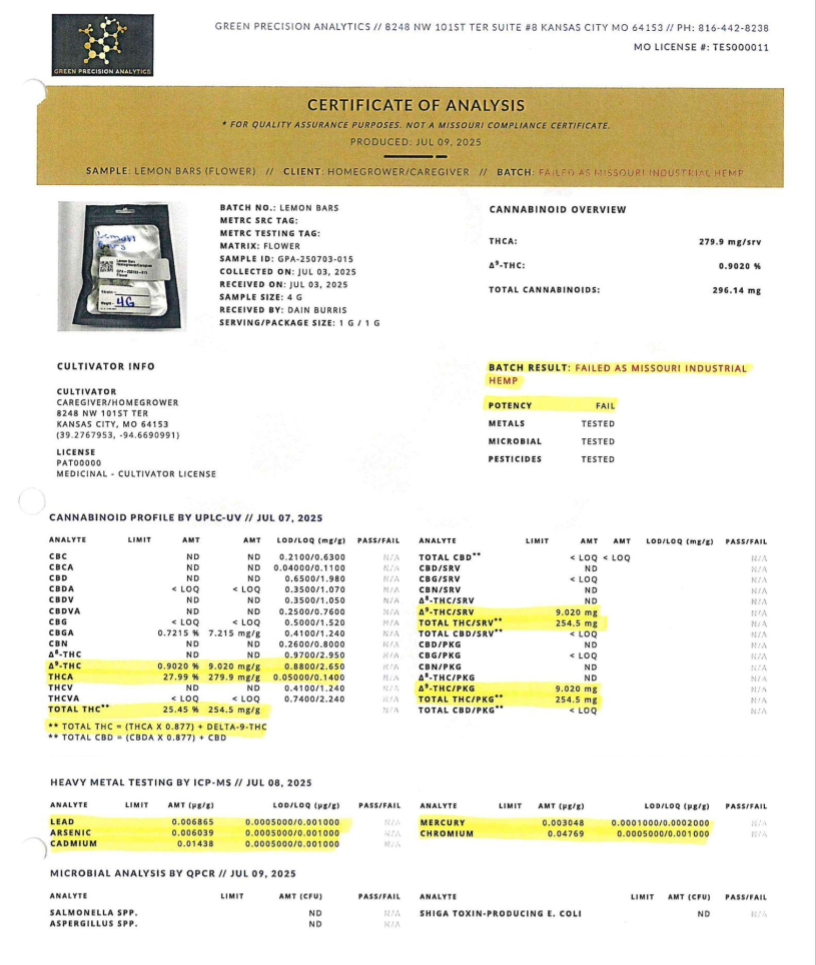
The Health Risks Are Real
Illegal Cannabis Products Are A Health Risk
Fake Dispensaries Sell Unregulated THC Products Contaminated with Heavy Metals, Pesticides, & Industrial Solvents
Illegal cannabis products from over 50 black market dispensaries in Missouri were tested at independent state-certified labs. These tests use the same standards every legal cannabis in Missouri is tested.
Over 95% of products exceeded the Federal THC limit, on average by over 20 times.
Over 30% failed for heavy metals, pesticides, mold.
Licensed dispensaries can only sell product produced locally and that have passed stringent testing for contaminants.
There is no denying it: when you buy from illegal stores, you ingest untested, unregulated products that contain harmful contaminants.
Buy legal means buy safe.
There are 5 heavy metals that the government regulates in all food and inhaled items.
All 5 heavy metals have been found in illegal cannabis.
Arsenic: known carcinogen, can cause skin, bladder, and lung cancers, plus heart and nervous system problems. Chronic exposure is associated with heart disease and diabetes.
Chromium: if inhaled/ingested, may cause lung and stomach cancers. Chronic exposure leads to liver and kidney damage, plus irritation of the nose and throat.
Lead: known neurotoxin that damages the brain, nervous system, kidneys, and circulatory system. Especially dangerous for children; causes permanent brain damage, learning disabilities, developmental delays. Causes high blood pressure, kidney damage, and reduced fertility in adults.
Cadmium: classified as a Group 1 Carcinogen (known to cause cancer in humans). It weakens bones and increases risk of fractures. It builds up in your kidneys over time resulting in kidney failure. An industrial pollutant used as a fertilizer and battery production.
Mercury: known neurotoxin, causing tremors, memory loss, mood swings. It interferes with fetal brain development in pregnancy, damages kidneys and lungs when inhaled, as it builds up in tissues since it doesn’t leave the body easily. This powerful neurotoxin affects coordination, also causes kidney and immune system failure.
What Heavy Metals Did They Find?
What Pesticides Did They Find?
These 6 dangerous pesticides found in illegal cannabis are prohibited in the production of legal cannabis.
Malathion: toxic pesticide, neurotoxin, possible carcinogen
Imidacloprid: neonicotinoid insecticide (neurotoxic) causes dizziness, difficulty breathing, vomiting, liver stress, thyroid disruption and the EPA classifies it to be carcinogenic. It interferes with nerve signaling in humans. It’s linked to developmental issues and hormone disruption.
Myclobutanil: a fungicide that releases cyanide when heated or burned. Inhalation risk: severe respiratory damage, toxic to heart and brain.
Piperonyl Butoxide: possible carcinogen, toxic to liver
Cyfluthrin: a synthetic pyrethroid insecticide that causes nerve damage and is highly toxic to children
Paclobutrazol: a Plant Growth regulator (PGR) not meant for human consumption, and is linked to liver damage and developmental toxicity in lab studies.
What Chemicals Did They Find?
There several chemicals and industrial solvents in illegal cannabis products that have severe health risks. All of these are banned in the regulated market. Here’s just a few:
Methanol: attacks the nervous system, causing dizziness, headaches, and seizures. Even small amounts can cause blindness by damaging the optic nerve. It breaks down into formaldehyde and formic acid inside the body which damages liver and kidneys. Ingesting or inhaling too much can cause coma or death.
Toluene: a chemical used in paint thinners and industrial solvents. It causes confusion, memory loss, dizziness, and long-term exposure can cause brain damage. When inhaled, lung damage is imminent. It’s also linked to development damage in unborn babies.
Acetonitrile: an industrial chemical (used in pharmaceuticals, plastics, and labs). It releases cyanide inside the body when metabolized. Exposure risks: headache, dizziness, nausea, difficulty breathing, and in higher amounts, it can be deadly.
